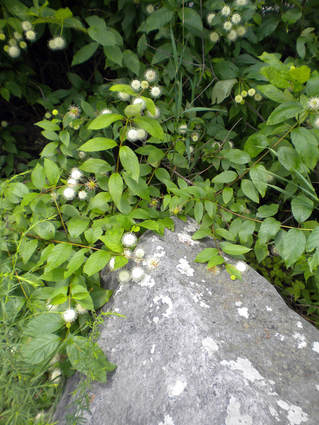A lake fills a narrow valley hemmed in by quartzite cliffs. Extending down from the cliffs, there is a long, straight-profiled slope of jumbled boulders (a talus), mostly bare but in some spots covered by trees and brush. The loose rocks, broken from the cliffs by frost, are jagged and irregular in shape. No soil can be seen between the boulders.
Dimensions Loose boulders of the talus slope rise 300 feet (90 m) above lake level, with 60-foot (18 m) cliffs standing above. The lake is half a mile (0.8 km) wide, and more than a mile (2 km) long. Most boulders are one to two yards/meters across.
Key Details
- Origin: The talus has the same steep slope everywhere, because the boulder pile has built up to the highest angle it can support and remain stable (this is called ‘angle of repose’). On a gentler slope, all boulders falling from above would come to rest near the top of the talus, not rolling any further, eventually making the whole slope steeper. If the slope angle were even more extreme than it is, all falling boulders would roll down to the slope base, building up a lower-angle ramp of rocks.
- Most of the large rocks will be stable if stepped on, but rare, smaller ones will shift or even topple if someone steps on them the wrong way.
- The gray-purple quartzite is a very hard rock, remaining mostly as large, sharp-cornered boulders when fractured. The rock surfaces are smooth and almost glassy in appearance, likely to be slippery when wet, except where roughened by lichen.
- Parts of the slope have been stabilized by trees, mostly evergreens, whose roots are anchored deep into the boulder pile. The ground surface below that foliage remains uneven and rocky. In rare spots on the open talus surface, especially at the slope base, shrubs and flowering plants have found root.
- New boulders are most likely to break off the cliff face and fall to the talus below when ground is freezing or thawing in colder times of the year. These rockfalls will occur one at a time, over hours or days. A boulder dropping onto the talus may bounce a considerable distance down the slope, before wedging into an empty pocket that can stop its momentum. Rarely, a falling or rolling boulder will set a few others in motion.
- The quartzite cliffs at the top of the talus are nearly vertical, in most places impassable without climbing equipment. A few locations offer walking routes to the cliff tops, with squeezes through narrow crevices and ascents on irregular rock steps. These pathways become much more hazardous in rainstorms.
- The base of the talus extends out into the lake, with water lapping around half-submerged boulders. The lake bed here is also a jumble of boulders, but sloping more gently.
Story Elements

- Uncertain footing will slow characters’ travel over the talus material. Still, they may be forced to traverse this ground to reach water or to walk the length of the valley.
- Through much of the winter, boulders on the slope will be partly buried by snow. With dark grey tree trunks and evergreen foliage added in, the mix of colors and textures will be striking. The snow may provide easier footing than the rocks, but each step in new snow will be chancy, with little indication whether it will sink an inch (cms) or one or two feet (half a meter). If the lake edge is solidly frozen, its flat ice with a bit of snow cover will make a quick alternate route along the valley length.
- In summer or fall, a well-angled boulder partway up the talus will provide a perch for someone to soak up sun, have a magnificent view, and encounter fewer insects than in the tree areas. A pair or group of people may find themselves sitting further apart or more closely together than they would normally do, in order to have comfortable seats.
- This pile of irregularly-shaped hunks of rock looks chaotic in close view, but makes an oddly consistent, linear slope in larger view. This characteristic could be highlighted to mirror similar aspects of a character (rough-edged but with an unerring moral compass) or situation (a seemingly straightforward problem has many thorny details). It certainly also poses practical contrasts in challenge related to scale (an impossibly complex climb for a tiny being is a smooth ramp or a huge one; small creatures can journey deep beneath what seems like a solid surface to a large one, traveling empty spaces between the jumbled boulders).
- A small object dropped on the talus could well be lost for good, unless the location is extremely well noted or marked. Conversely, a hidden recess between boulders might be the place for an accidental find of an interesting/useful item.
- Because the boulders are at the stable angle of repose, almost nothing (technology, magic, nature knowledge) will start an ‘avalanche’ (thousands of boulders coming down at once). In an earthquake, individual boulders would come loose and roll down the slope, but the majority of the boulders would remain in place.
- While not likely to actually cause harm to characters, times of boulders falling from the cliffs in winter would create an intense story background. Rocks falling as frequently as every few minutes across the landscape would be experienced as a series of noisy crashes, echoing through the icy air and add a feeling of random menace to the scene.
- Growling thunder and the beginning patter of raindrops can introduce a sudden need to get off the talus or top of the cliffs. The urge for speed will be at odds with the less certain footing on wet, smooth-textured rock. Areas of trees can give some added security for a quick descent.
- People who know the area, and so know the safe paths to climb to or descend from the cliff top, will have an advantage in any ticking-clock scenario.
- A threat emerging from the water could force characters on the lake edge up onto the steeper talus slope.
- Combat dynamics:
- A group crossing open areas of the talus will be exposed to view or attack from distance, and hampered by the difficult footing in attempts to dodge or flee for cover. Individuals may find momentary shelter in gaps between large boulders.
- In close combat, an empty space between boulders may trap a foot or leg. An uncontrolled fall on the sharp-cornered boulders may have unpleasant consequences.
- It might be possible to set one of the smaller boulders moving as an attack on those below, especially if an unstable rock has already been found by stepping there. Once it gains momentum, such a boulder will bound down the slope in a series of crashing impacts rather than a smooth roll, unpredictably shifting direction as it bounces off more massive boulders.
Reference Location
Devil’s Lake State Park, south-central Wisconsin.
© Rice-Snows 2018
Proudly powered by Weebly





